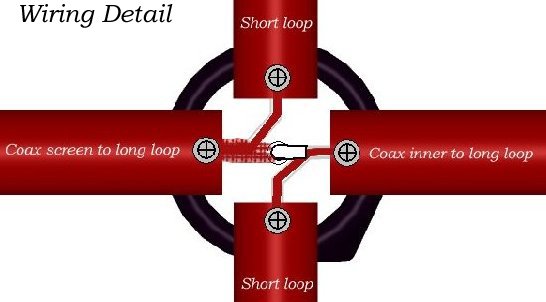
|
|
|
|
Quadrifilar Helix Antennas
The purpose of this page is to provide information and links about Quadrifilar Helix Antennas. There are a few links at the foot of the page - if you want me add yours please email the details. What is a Quadrifilar Helix Antenna (QHA) ? Simply - It's the best antenna to use for APT satellite reception - the featured antenna is depicted on the left. To paraphrase M. Walter Maxwell "It comprises two bifilar helical loops oriented in mutual orthogonal relationship on a common axis. The terminals of each loop are fed in antiphase and the currents in the two loops are in phase quadrature. By selecting the appropriate configuration of the loops, a wide range of pattern shapes is available". The basic form of resonant QHA was developed by Dr. C. C. Kilgus of the Applied Physics Laboratory, John-Hopkins University, Silver Spring, Md. and published in December 1970 in "The Microwave Journal". Since then a lot of research has been done into the number of turns and length/diameter ratios. All of these affect the radiation pattern. The "traditional" fractional turn design produces a cardioid radiation pattern. It has been found that tall narrow QHA exhibit a "shaped-conical" pattern with high gains to the horizon and decreased gain overhead, which is much better suited to APT ground stations (See polar diagram examples). Most of the published data and designs on narrow antennas however have been more suited to UHF and do not translate well to 137.5Mhz. One of the best is a narrow 5 turn, but at the frequencies we are interested in would make an antenna 7 metres high!
A Solution? This design came about in the search for better gain at the horizon and yet still make construction easy. After a lot of discussion, experimenting and some frantic NEC modeling John Boyer came up with the dimensions for this one. 
As you can see from the polar diagram above, this model exhibits a good compromise between the two previous examples. The +dB figures give the direction of highest gain, the - figures the direction of greatest loss. For more information on NEC and where to get it look at my NEC page. John and myself have both built this one and find it has excellent reception properties. Its quite easy to get full horizon to horizon passes!
Note - these are cutting dimensions and assume that 90 degree elbows NOT bends are used - The dimensions on the drawing are from centre to centre of the respective elements - you may have to adjust your cutting sizes accordingly.
Drill 4 - 8mm holes at 90 degrees to each other 25mm from the end of the mast - make sure the holes are Square and in the same plane! Mark and drill the bottom holes remembering they are in opposing pairs spaced 100mm apart - you're advised to check the measurements at least twice before drilling!!! Drill a 7mm hole near the top of the mast for the cable entry. 
Drill pilot holes in the 4 top elements for self-tapping screws and assemble top tubes, push coax through hole and make top connections with screws. Wrap the coax 4 times around the mast and tape/glue in position (balun).
Push the elbows onto the top tubes and measure from the centre of each leg - it should be 200mm, NB -you may have to cut more off if you used swept bends rather than tight 90 degree elbows. Assemble bottom tubes, make sure they are central and square to top tubes. Bend helixes to suit - tip - try and find a former of some type; a suitable log or large pipe makes the bends nice and neat. When your happy with the shape solder up the elbows. It should appear circular when viewed from the end. 
Check the connections and cap the top end of the pipe. The copper tubes can be fixed to the mast using glue/silicon sealer and/or tape - make sure you seal the coax entry hole. Push a suitable piece of wood up the bottom end to avoid crushing the PVC tube too much when clamping to the mast. I hope you'll give it a try - it really is worth the effort. Click here to download the construction notes and illustrations.
Links
|
Enviar correo electrónico a 30 STV con preguntas o comentarios sobre
este sitio Web.
|